Pension Records for 'non-UK' soldiers
- Home
- World War I Articles
- Pension Records for 'non-UK' soldiers
It was initially believed that the WFA's Pension Cards and Ledgers were only for claims for pensions for men who came from the British Isles. As the new set of cards for pension claims for men who were killed is investigated, it has become clear that the original 'UK only' description needs to be expanded.
A number of what can loosely be described as 'non-UK servicemen' can be found in the records. In the article below, I take a look at some of the many examples that can be found.
South Africa
By far the largest 'non-UK' set are those of men from South Africa. The South African Infantry Brigade was - for most of the war - part of the 9th (Scottish) Division and comprised four battalions. These men were not technically a force of the South Africa government as they were raised for specific overseas services to the War Office and consequently the men sometimes seem to have been paid under British rules and sometimes under South African rules.[1] It seems that in 1918 the men were given the choice of drawing British Pay if more favourable for them.
Here are three examples:
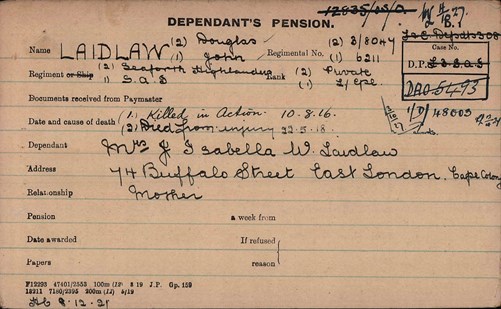
John Laidlaw (above) is buried at Dar es Salaam War Cemetery, in Tanzania
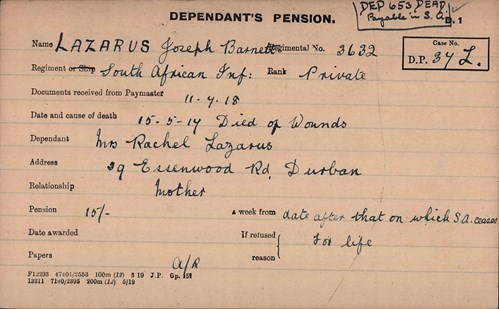
Joseph Lazarus (above) is buried at Willesden Jewish Cemetery, in the UK.

Wilfred Lamude (above) is buried at Faubourg d'Amiens Cemetery in Arras, France.
By manipulating the search criteria, hundreds of others can be found. For example input "1st S A Inf", followed by "2nd, 3rd and 4th" S A Inf , with and without the gaps between "S" and "A" and you will get results. Other results can be found by inputting such words as "Cape", "Orange", "Rhodesia" as a place.
Below are a few cards which illustrate the wide variety of other results that can be located for men from South Africa.

Driver Eyssen is buried at Les Baraques Military Cemetery, Sangatte (near Calais)
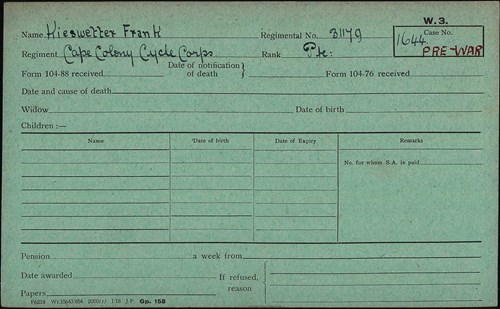
No trace of Frank Kieswetter can be found on the CWGC database.

Moses Dampies is buried at Morogoro Cemetery, Tanzania

John Thrueben is buried at Dar es Salaam War Cemetery, in Tanzania

Frans Preis is buried at Voi Cemetery, Kenya.
Australia
Some Australians soldiers have been found - it is unclear why the pensions for these soldiers were claimed from (and paid by) the British Government. Below is the card (and corresponding ledger) for Syndey Spiller.
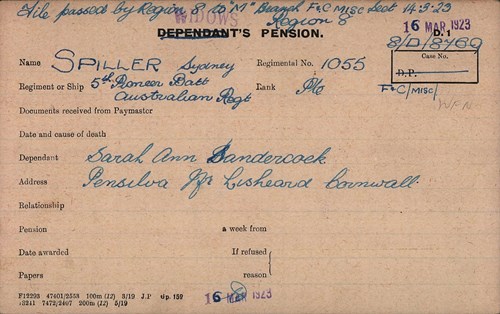
Sydney Spiller is buried at Lonpre-les-Corps Saints British Cemetery in France, but his date of death is different to that shown on the ledger (below).

And below the card for Edward Skillicorn.
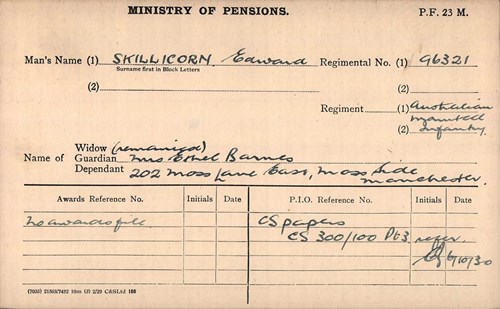
Despite the unusual surname, no trace of Edward Skillicorn (of the Australian Mounted Infantry) can be located in the CWGC's database.
Canada
Far more numerous than the Australian cards are Canadian Cards. It is possible this is because these cases were men who had previously served in the British Army before the war.

It may be that the 'pre-war' pension cards such as that for 'F Muir' detail men who did not necessarily serve in the First World War.
Other cards seem to cross reference siblings who served in the British Army

Cecil Charles Algar is buried at Vis-en-Artois Cemetery in France.
Boone's widow clearly lived in or moved to the USA:
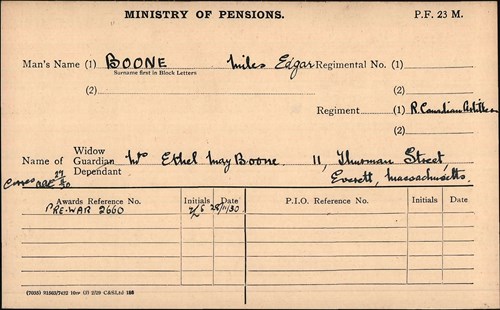
However this is again either a case of 'non-commemoration' or a card of a pre-war pensioner (the phrase is clearly stated on the card) which is for a soldier who was not killed in the First World War.
Another example of a card for a soldier serving in the CEF is below. John Bewsher, certainly was a fatality of the war, being commemorated on the Menin Gate Memorial, Ypres.

Perhaps the annotation on the Ledger here may provide some clues as to the process? Private Frederick West is buried at Winnipeg (Brookside) Cemetery, Manitoba.
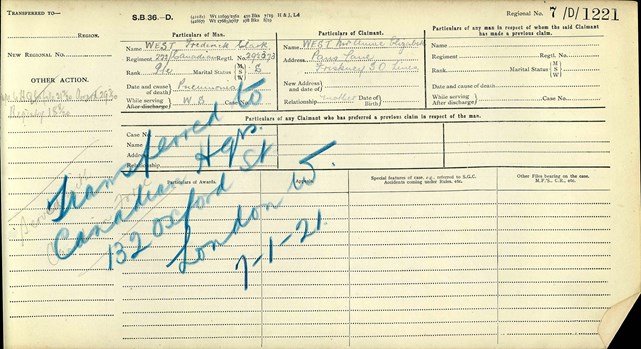
Men from Newfoundland can be found on the WFA's library edition of Fold3. Below is one example - the date of death on this card is particularly late. A sample of the cards that appear when inputting 'Newfoundland' as a keyword suggests these are largely men who served in the Royal Navy. It may be assumed from this that the pensions of the men from the (Royal) Newfoundland Regiment were not paid by the British Government. See footnote [1] below.

The Newfoundland Forestry Corps, in which George Moyles served, was a non-combatant military unit that formed in April 1917 to supply Britain with the lumber it needed for the war effort. George's date of death of 1923 means he is not commemorated by the CWGC.
There are several dozen cards for men who served in the Chinese Labour Corps (all of whom are seemingly of British extraction).
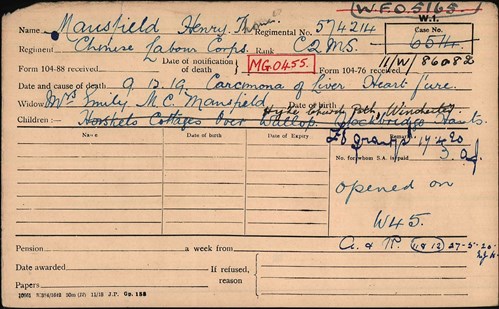
Henry Thomas Mansfield is not commemorated by the CWGC, although his date of death was 9 December 1919. There is no reference to a pension being awarded so it is possible a claim for a pension was declined.

Charles Henry Butcher is detailed by the CWGC as being in the 'Labour Corps' when he died in September 1920. He is buried Pontnewydd (Holy Trinity) Churchyard in Wales.
Men who served in various units raised in Ceylon are also held

There is no obvious candidate for 'Toner' despite the 'Hampshire Regiment' clue on the card.

The ledger for Frederick Henry Golden indicates he survived the war and was discharged in 1920. This serves to remind all users of these records that the ledgers detail men who survived as well as those who were killed in the war.
The Bermuda Volunteer Rifles were famously involved with the 1/Lincs on the first day of the Battle of the Somme. There are numerous examples of men from Bermuda within the pension records...
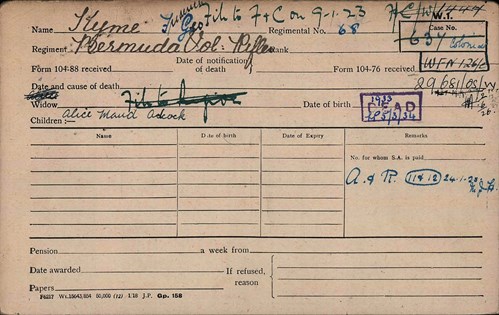
The card for George Kyme contains no date of death, so it may be that this soldier survived the war, despite, for some reason, this being a card within the 'soldiers died' set.

Again, the ledger (above) is for that of a soldier (Private Willoughby) who survived the war, despite there being no date of discharge provided.
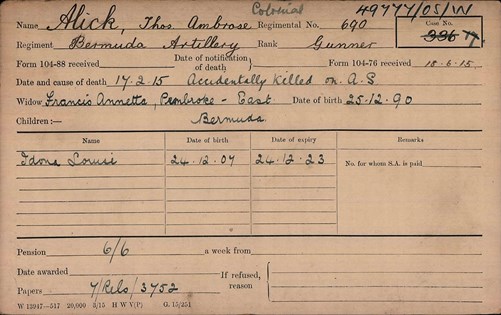
There are certain contradictions for the card for Thomas Ambrose Alick with his entry on the CWGC database. He is commemorated by as 'Ambrose Richard' although his regimental number and the 'accidental injuries' reference match.
A battery of the RGA was raised from the Hong Kong and Singapore [see 'further reading' below, being a new article on the WFA web site], and these men clearly were entitled to a British pension. A similar unit, also part of the RGA was formed in Sierra Leone, but no examples of cards of men from this unit have so far come to light.

No trace of a commemoration can be found for Sawan Khan (see above), but his date of death is not recorded on this card, so be may have died after the War Grave Commission's 'cut-off date'.

Bur Singh (above) and Sultan Ahmed (as Sultan Ahmad) (below) are commemorated by the CWGC at the Heliopolis (Port Tewfik) Memorial in Cairo.

A few examples of men from the Kings African Rifles are also evident, as are cards if a search is made under the West African Frontier Force.

Once again, contradictions in records appear for James Horsburg. His name is given as 'Horsburgh' by the CWGC. He is buried at Dar es Salaam War Cemetery.

Colour Sergeant CJ Francis (attached to the Nigerian Regiment, WAFF) is buried in the only CWGC grave at Abunerek, Nigeria.
There are a number of cards representing claims for pensions for men who served in both the British West India Regiment and the British West Indies Regiment (these being two different units, despite the similarity in the names).

CSM Richards has proved untraceable - again the lack of date of death on this card is suggestive.
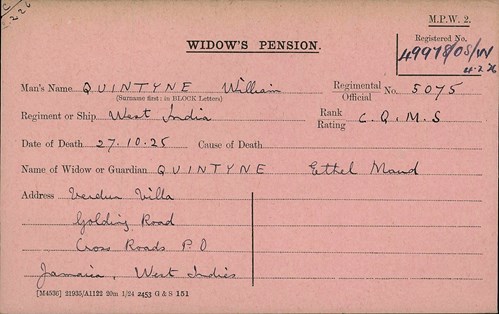
On the other hand, William Quintyne's card gives a precise date of 27 October 1925)

Frank William Grand Jordan is detailed as 'Jordon' by the CWGC. The grave registration details for Frank confirm his surname is indeed as set out on the Pension Card. He is buried at Ramleh War Cemetery. These pension cards - although not immune error, may assist in correcting transcription errors such as this on the CWGC's database.

Private Dyce's card gives no date of death, but we do know (from the CWGC database) that he died on 27 May 1918. He is buried at Taranto Town Cemetery Extension, Italy.
One additional interesting matter that has come to light during this research is that the handwriting of certain clerks can be recognised.
We have these from one clerk:

Frederick Barton is commemorated on the Vimy Memorial. Why his card is so incomplete is a mystery.
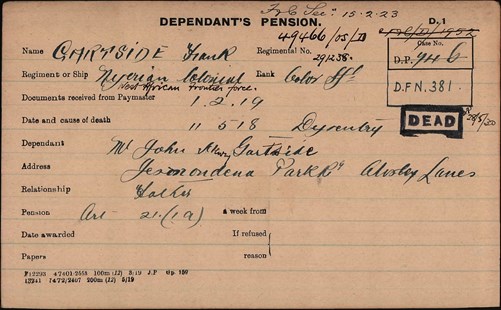
Frank Gartside's card, by contrast is well detailed. Frank is buried at Pemba Cemetery, Mozambique.
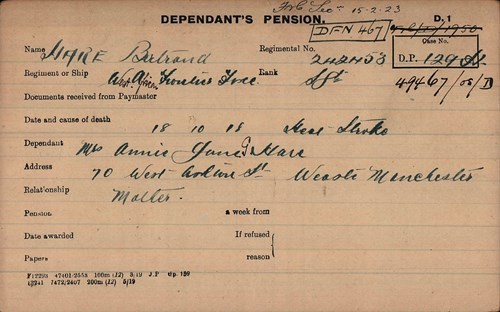
Bertrand (Bertram according to the CWGC) Hare, who died of 'heat stroke', is the third of these examples completed by the same clerk. Hare is buried at Lokoja Town cemetery in Nigeria.
And these cards from another clerk.
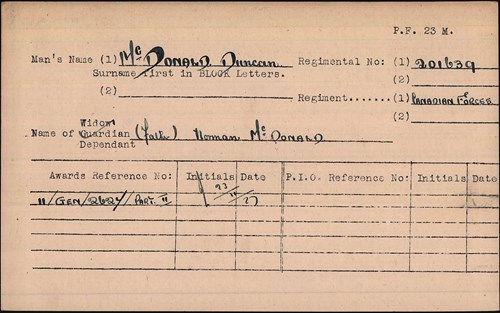
Duncan McDonald (1st Battalion, CEF) is buried in Ecoivres Military Cemetery, Mont-St Eloi.

The above card for Norman Smith is one from the yet to be published 'soldiers survived' set. The fact that Queensland Imperial Bushmen were a unit raised for service in the Boer War is intriguing. Did Smith also serve in the First World War?
And these from a third clerk (who also provided the card above for the Canadian soldier 'Muir' and the Cape Colony Cyclist example, also shown above). It would seem that the pre-war cases were probably dealt with by a much smaller staff, hence the frequency of this clerk's cards in the 'pre-war' set. None of the three final examples can be located on the CWGC database.
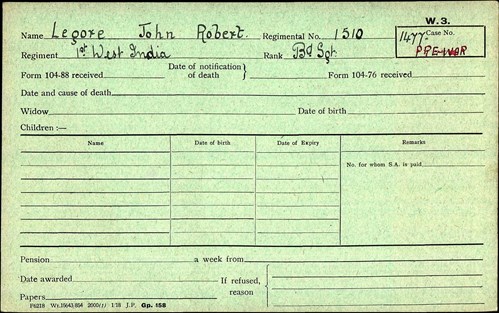


[1] The SA troops discharged in the UK had their pensions administered by the War Office but the monies were paid by the SA Government - probably under some sort of reciprocal scheme for the monies. It is possible a similar scheme was set up with other colonies and dominions.
My thanks to Craig Suddick for input into this article.
David Tattersfield
October 2019
Further Reading:
The Hong Kong and Singapore Mountain Battery in Egypt, Sinai and Palestine 1915 - 1918





